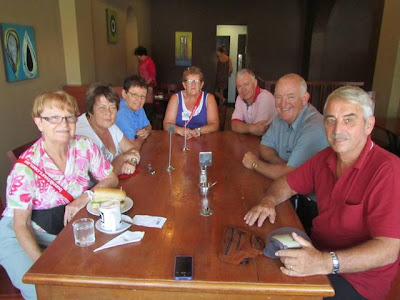Sunday 10th – Monday 11th February
Arrived in Vientiane, the capital of Laos and noticed
immediately that the French influence is much more noticeable in both signs and
buildings. It looks more affluent than other places we have been.
We had lunch at Joma bakery, owned by the Starbucks chain
but not allowed to be named as such by the government, the first truly western
meal we have had since we left home.
 |
| The Super 7 lunching in Vientiane |
After lunch we visited the Golden Stupa, an important
freedom monument in Vientiane. A stupa is a place which houses the ashes of
ancestors, a bit like a tombstone, but it is usually a lavishly ornate
structure. The Golden Stupa used to be covered with gold which was long ago
stolen by colonial invaders. Now it’s only painted gold.
We visited Sisaket Museum devoted to Buddha, one containing many
hundreds of statues from average size to very tiny. Also we were allowed to
enter another Buddhist temple, filled with hundreds of people as it was Chinese
New Year, and many had a long weekend, the temple was extraordinarily busy. We
noticed an interesting example of recycling. People purchased floral offerings
to place in the temple; when there were too many one of the officials removed
some and returned them to the entrance for re-sale. |
| Sisaket Museum full of Buddhas |
Our next stop was a visit to the Nam Ngum hydro dam, which forms the largest man-made lake in Laos, with over 4 000 islands. Many are unoccupied but some are home to isolated communities, and 2 house prisoners. We had lunch on a cruise boat followed by a tour of the lake.
One the way we stopped at a silk weaving factory which is
staffed exclusively by women working manually operated looms. The fabric they
produce is excellent and made primarily for the domestic market. All Lao women
in public life must wear these distinctive straight wrap-around skirts with a
decorative border and sashes. School students also wear the same type of skirt.
Following our cruise we visited a salt factory which employs
most of the village. The salt is distilled from artesian water by heating, hot
horrible work. After further processing the salt is packaged by the women. The
kids of the village flocked around us, and when we gave them some sweets before
we left one of the group said it was worse than feeding seagulls.
 |
| Salt being distilled |
Our final stop of the day was at a small village market.
Here the people have little access to protein – obviously they don’t have large
animals – so the market sells an array of alternate small animals. These
include snakes, rats, hamsters, dried frogs and live small birds. There were
chickens are probably a few other unrecognisable items. No-one from our group
was inclined to purchase anything.
 |
| Snake ready to buy |
One peculiarity we noticed was that many of the villages
were ”strip settlements” lining the main road. We were told that in order to
reduce population growth electricity (or
electric city as pronounced by our guide) was supplied to places along the main
road, but not much further. Obviously the government has great confidence in
television and other electrical devices as contraceptives.
 |
| ATMs in glass cages along the roadside |
 |
| A typical clothing store displaying waares on the footpath |
We finished out tour of Vientiane and surrounding districts
with a visit to their most imposing monument, the Arc de Triomphe copycat
monument, which was originally intended to be the tomb of the unknown soldier. It is surrounded by
beautiful gardens and fountains.
 |
| Patuxai, the Peace Monument |
Chinese New Year was an interesting time to be in Vientiane
as the streets were full of happy relaxed people – walking the embankment along
the Mekong, participating in an open air Zumba class, eating out, prancing the
streets with the dragon and accompanying drums, all wearing red, or new
clothes. Buildings were decorated with
red lanterns and everywhere there was a great vibe.










No comments:
Post a Comment
We'd love to hear from you. If you're unsure how to post a comment choose Anonymous from the drop down box below.